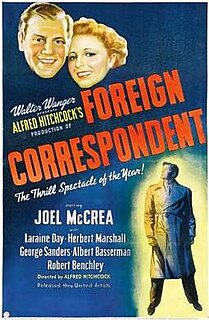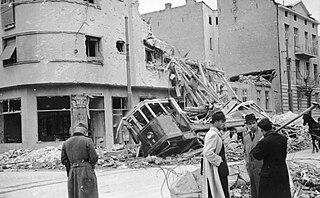
Blitzkrieg is a word used to describe a surprise attack using a rapid, overwhelming force concentration that may consist of armored and motorized or mechanized infantry formations, together with close air support, that has the intent to break through the opponent's lines of defense, then dislocate the defenders, unbalance the enemy by making it difficult to respond to the continuously changing front, and defeat them in a decisive Vernichtungsschlacht: a battle of annihilation.

The Battle of Britain, also known as the Air Battle for England, was a military campaign of the Second World War, in which the Royal Air Force (RAF) and the Fleet Air Arm (FAA) of the Royal Navy defended the United Kingdom (UK) against large-scale attacks by Nazi Germany's air force, the Luftwaffe. It has been described as the first major military campaign fought entirely by air forces. The British officially recognise the battle's duration as being from 10 July until 31 October 1940, which overlaps the period of large-scale night attacks known as the Blitz, that lasted from 7 September 1940 to 11 May 1941. German historians do not accept this subdivision and regard the battle as a single campaign lasting from July 1940 to May 1941, including the Blitz.

Foreign Correspondent is a 1940 American black-and-white spy thriller film directed by Alfred Hitchcock. It tells the story of an American reporter based in Britain who tries to expose enemy spies involved in a fictional continent-wide conspiracy in the prelude to World War II. It stars Joel McCrea and features 19-year-old Laraine Day, Herbert Marshall, George Sanders, Albert Basserman, and Robert Benchley, along with Edmund Gwenn.

The bombing of Dresden was a joint British and American aerial bombing attack on the city of Dresden, the capital of the German state of Saxony, during World War II. In four raids between 13 and 15 February 1945, 772 heavy bombers of the Royal Air Force (RAF) and 527 of the United States Army Air Forces (USAAF) dropped more than 3,900 tons of high-explosive bombs and incendiary devices on the city. The bombing and the resulting firestorm destroyed more than 1,600 acres (6.5 km2) of the city centre. An estimated 22,700 to 25,000 people were killed. Three more USAAF air raids followed, two occurring on 2 March aimed at the city's railway marshalling yard and one smaller raid on 17 April aimed at industrial areas.

The Blitz was a German bombing campaign against the United Kingdom in 1940 and 1941, during the Second World War. The term was first used by the British press and originated from the term Blitzkrieg, the German word meaning 'lightning war'.

World War II (1939–1945) involved sustained strategic bombing of railways, harbours, cities, workers' and civilian housing, and industrial districts in enemy territory. Strategic bombing as a military strategy is distinct both from close air support of ground forces and from tactical air power. During World War II, many military strategists of air power believed that air forces could win major victories by attacking industrial and political infrastructure, rather than purely military targets. Strategic bombing often involved bombing areas inhabited by civilians, and some campaigns were deliberately designed to target civilian populations in order to terrorize them and disrupt their usual activities. International law at the outset of World War II did not specifically forbid the aerial bombardment of cities – despite the prior occurrence of such bombing during World War I (1914–1918), the Spanish Civil War (1936–1939), and the Second Sino-Japanese War (1937–1945).

Berlin, then the capital of Nazi Germany, was subject to 363 air raids during the Second World War. It was bombed by the RAF Bomber Command between 1940 and 1945, by the USAAF Eighth Air Force between 1943 and 1945, and the French Air Force between 1944 and 1945, as part of the Allied campaign of strategic bombing of Germany. It was also attacked by aircraft of the Red Air Force, in 1941 and particularly in 1945 as Soviet forces closed on the city. British bombers dropped 45,517 tons of bombs, while American aircraft dropped 22,090.3 tons. As the bombings continued, more and more people fled the city. By May 1945, 1.7 million people had fled.

No. 303 Squadron RAF, also known as the 303rd "Tadeusz Kościuszko Warsaw" Fighter Squadron, was one of two Polish squadrons that fought during the Battle of Britain along with No. 302 Squadron, of 16 total Polish squadrons in the Royal Air Force (RAF) during the Second World War. Flying Hawker Hurricanes, the squadron claimed the largest number of aircraft shot down of the 66 Allied fighter squadrons engaged in the Battle of Britain, even though it joined the fray two months after the battle had begun.

Operation Retribution, also known as Operation Punishment, was the April 1941 German bombing of Belgrade, the capital of Yugoslavia, in retaliation for the coup d'état that overthrew the government that had signed the Tripartite Pact. The bombing occurred in the first days of the German-led Axis invasion of Yugoslavia during World War II. The Royal Yugoslav Army Air Force (VVKJ) had only 77 modern fighter aircraft available to defend Belgrade against the hundreds of German fighters and bombers that struck in the first wave early on 6 April. Three days prior, VVKJ Major Vladimir Kren had defected to the Germans, disclosing the locations of multiple military assets and divulging the VVKJ's codes.

No. 315 Polish Fighter Squadron was one of several Polish squadrons in the Royal Air Force (RAF) during the Second World War. It was formed as part of an agreement between the Polish Government in Exile and the United Kingdom in 1941. It was named after the city of Dęblin, where the main Polish Air Force Academy has been located since 1927.

The Battle of Britain was the fourth of Frank Capra's Why We Fight series of seven propaganda films, which made the case for fighting and winning the Second World War. It was released in 1943 and concentrated on the German bombardment of the United Kingdom in anticipation of Operation Sea Lion, the planned German invasion.

Target for Tonight is a 1941 British World War II documentary film billed as filmed and acted by the Royal Air Force, all during wartime operations. It was directed by Harry Watt for the Crown Film Unit. The film is about the crew of a Wellington bomber taking part in a bombing mission over Nazi Germany. The film won an honorary Academy Award in 1942 as Best Documentary by the National Board of Review. Despite purporting to be a documentary there are multiple indicators that it is not quite as such: film shots include studio shots taken from the exterior of the aircraft looking into the cockpit whilst "in flight"; several stilted sections of dialogue are clearly scripted; on the ground shots of bombing are done using model trains; and several actors appear. The film does give a unique insight into the confined nature of the Wellington's interior and some of the nuances of day to day operation such as ground crew holding a blanket over the engine while it starts to regulate oxygen intake.
The following events occurred in August 1940:

The Valour and the Horror is a Canadian television documentary miniseries, which aired on CBC Television in 1992. The series investigated three significant Canadian battles from the Second World War and was a co-production between the CBC, the National Film Board of Canada (NFB) and Galafilm Inc. The films were also broadcast by Radio-Canada, the French network of the CBC. The series was written by Brian McKenna, an award-winning journalist and founding producer of The Fifth Estate and his brother, Terence McKenna, and was directed by Brian McKenna.
This is a timeline of events that stretched over the period of World War II.
Christmas Under Fire is a 1941 British short documentary film directed by Harry Watt for the Crown Film Unit of the Ministry of Information. It was conceived as propaganda primarily for an American audience, to raise support for the Allied cause during the Second World War. Produced in the context of German bombings of British cities, it depicts the resilience of British civilians despite the hardships they suffered during Christmas 1940, by showing the continuation of Christmas traditions in the face of the disruptions caused by war. The film is a sequel to London Can Take It!, with the same narrator, Quentin Reynolds. It was nominated for an Academy Award for Best Documentary Short, which was won by Churchill's Island.

The United Kingdom home front during World War II covers the political, social and economic history during 1939–1945.
Large numbers of British civilians engaged in trekking during the Blitz. This involved leaving cities at night to sleep in nearby towns and rural areas. The practice was most prevalent in provincial cities during early 1941. While the British Government was concerned that trekking indicated that civilian morale was under strain, the practice was generally motivated by a desire to avoid the risk of death or injury and to be able to sleep.













